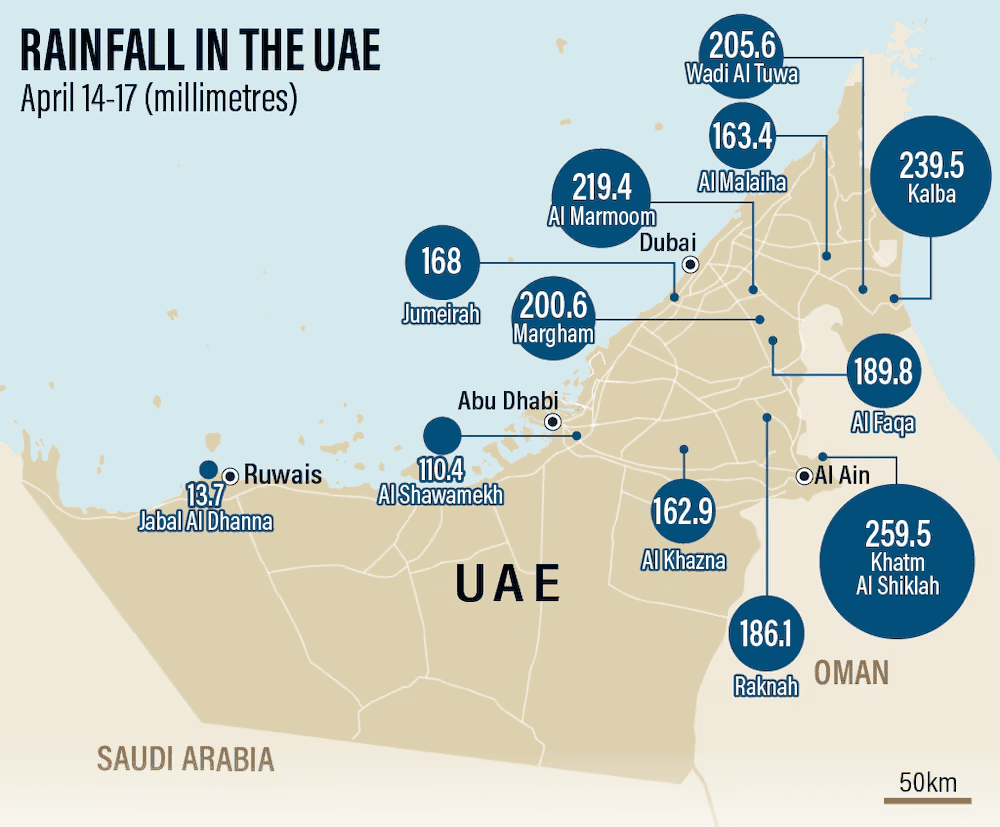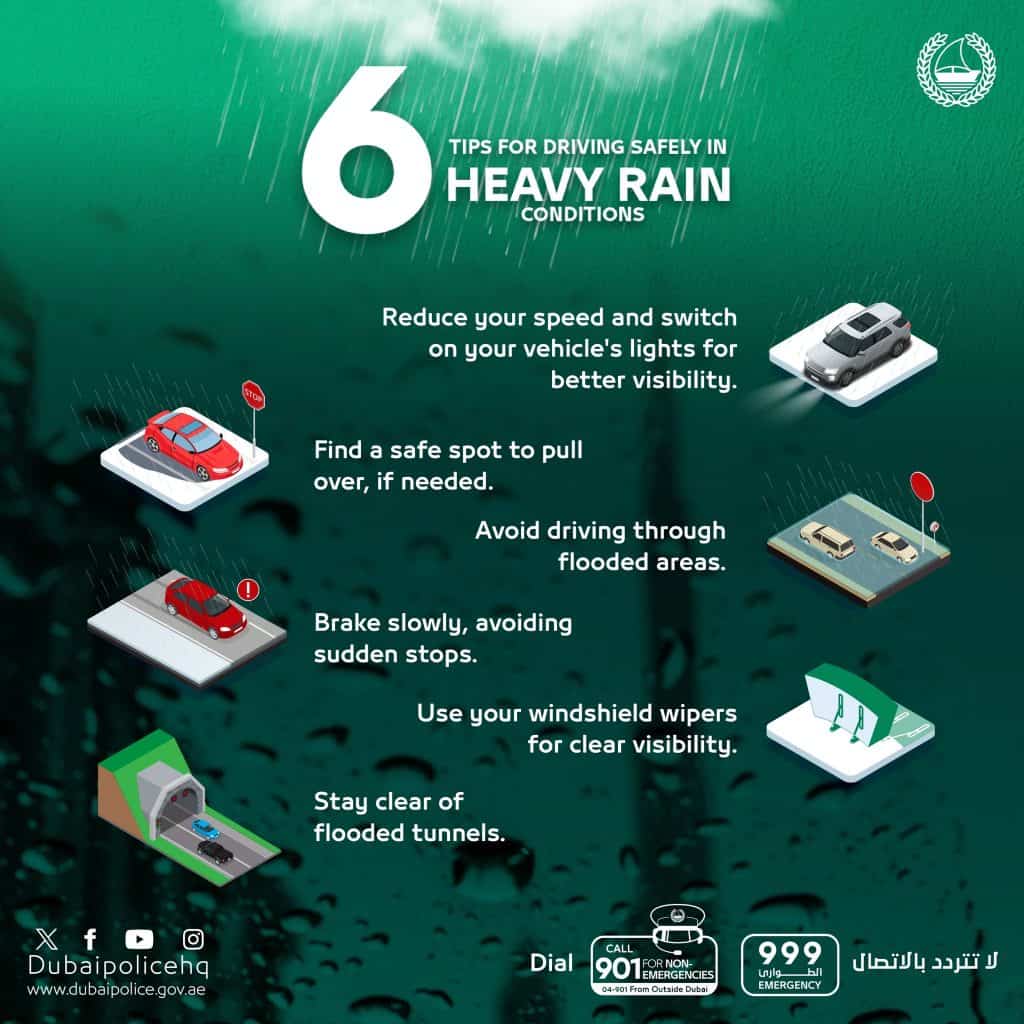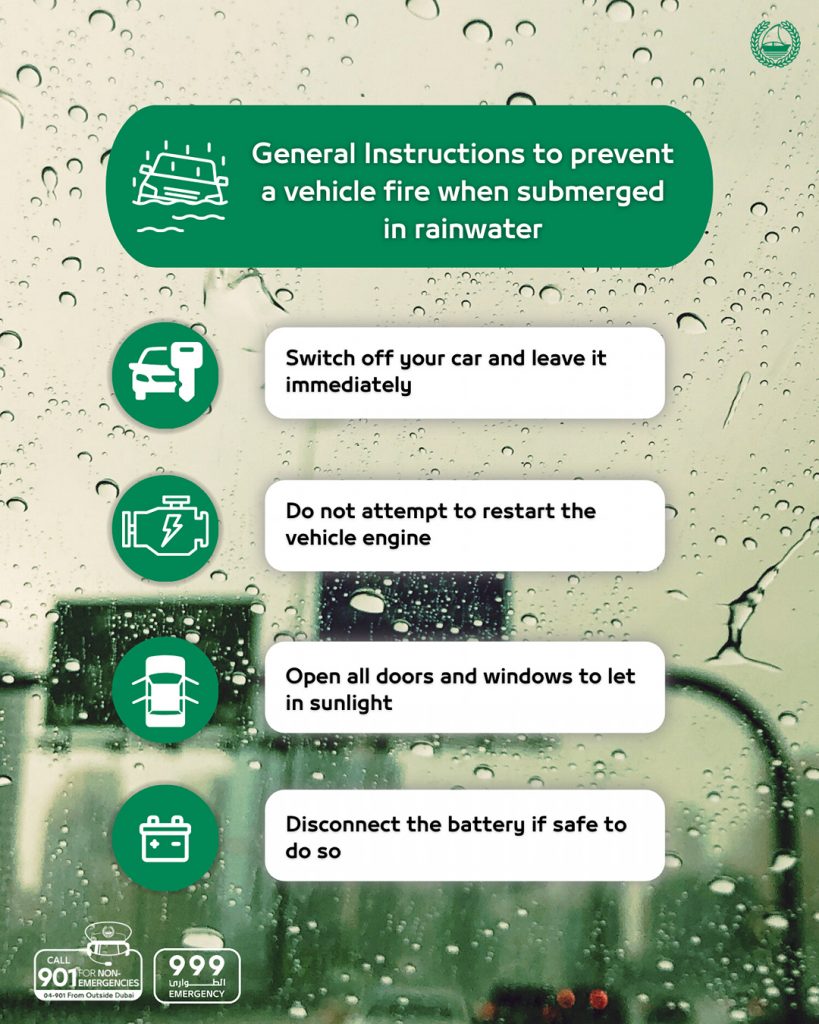Your Safety Guide to Rain in the UAE – Tips & Tricks
Picture this: You’re cruising down UAE’s coastal highways, the sun-kissed desert landscapes framing your journey, when suddenly, the heavens open up. Rain pours down in sheets, turning the roads into slippery slopes and the streets into rivers. In these moments, knowing how to navigate the rain is not just a matter of comfort, but of safety. As the heavy downpour soaks the United Arab Emirates, it’s crucial to equip yourself with the knowledge to stay safe amidst the downpour.

Recorded Rainfall in the UAE on April 14-17 2024.
Tips for Safe Driving In The Rain
Rainy weather significantly increases the risk of accidents on the roads. To mitigate this risk, adhere to the following tips to ensure safe navigation through the rainy weather in the UAE.
- Maintain a Safe Distance
This tip is paramount for safe driving in adverse weather conditions. When roads are wet, braking distances can significantly increase due to reduced tire traction. By maintaining a safe distance between your vehicle and the one in front of you, you provide yourself with ample reaction time in case of sudden stops or emergencies. A general rule of thumb is to double the typical following distance in dry conditions, allowing at least three to four seconds between your car and the vehicle ahead.
- Turn on Your Lights
Visibility is key to safe driving, especially when rain or storm clouds obscure natural light. Even during daylight hours, rainy weather can diminish visibility for both drivers and pedestrians. Therefore, it’s essential to illuminate your vehicle by turning on your headlights. This not only helps you see the road more clearly but also makes your vehicle more visible to other drivers, reducing the risk of accidents, particularly in low-light or heavy rain conditions.
- Slow Down
Adjusting your speed according to road conditions is crucial for maintaining control of your vehicle in rainy or stormy weather. Wet roads can significantly reduce tire grip and increase the likelihood of hydroplaning, where your tires lose contact with the road surface due to a thin layer of water. To mitigate this risk, reduce your speed and drive at a pace that allows you to maintain control of your vehicle. Remember, it’s always better to arrive safely at your destination a bit later than to risk a collision by driving too fast for the conditions.
- Avoid Sudden Movements
Abrupt maneuvers such as sharp turns or sudden braking can be hazardous on wet or slippery roads. These actions can lead to loss of traction and result in skidding or hydroplaning, increasing the likelihood of losing control of your vehicle. To prevent skidding, practice smooth and gradual steering and braking movements. If you find yourself hydroplaning, remain calm, ease off the accelerator, and steer gently in the direction you want to go until you regain traction.
Source: Dubai Police Twitter
By adhering to these expert tips, drivers can significantly enhance their safety and that of others on the road during rainy or stormy weather conditions. Remember, proactive measures and cautious driving habits are the keys to navigating adverse weather with confidence and competence.
The Do’s and Don’ts in UAE’s Rainy Weather
In the UAE, where rain is a rare phenomenon, it’s essential to know how to adapt to the weather:
The Do’s:
- Plan Ahead: Before embarking on any journey, especially during the rainy season, plan your route and schedule to allow for potential delays due to inclement weather.
- Keep Emergency Supplies: Equip your vehicle with essential emergency supplies such as a flashlight, first-aid kit, non-perishable food, water, and blankets in case you get stranded during heavy rain or storms.
- Maintain Vehicle Maintenance: Ensure your vehicle is in optimal condition by checking windshield wipers, tire tread, brakes, and headlights regularly. Proper maintenance reduces the risk of vehicle failure during rainy weather.
- Stay Informed: Continuously monitor weather updates from reliable sources such as meteorological agencies or weather apps to stay informed about changing weather patterns and forecasts.
- Use Fog Lights Appropriately: In regions where fog accompanies rain, use fog lights if your vehicle is equipped with them. However, avoid using high beams as they can reflect off the fog and impair visibility further.
- Follow Traffic Signs and Signals: Adhere to traffic signs, signals, and directives from authorities, especially during rainy weather when road conditions may change rapidly.
- Be Extra Cautious at Intersections: Approach intersections with extra caution, as wet roads can increase the likelihood of skidding or loss of traction, particularly when braking.
- Drive Defensively: Anticipate the actions of other drivers and maintain a defensive driving mindset, allowing for sudden stops or lane changes.
- Stay Calm During Hydroplaning: If your vehicle hydroplanes, remain calm, avoid sudden movements, and steer gently in the direction you want to go until traction is regained.
- Keep a Safe Distance from Large Vehicles: Heavy rainfall can impair the visibility of large trucks and buses, so maintain a safe distance to allow for better visibility and reaction time.
- Avoid Cruise Control: Refrain from using cruise control in rainy conditions as it can reduce your ability to react quickly to changing road conditions.
- Use Turn Signals Early: Signal your intentions well in advance of turning or changing lanes to give other drivers more time to react, especially in reduced visibility.
- Be Mindful of Aquaplaning on Curves: Exercise caution when navigating curves or bends in the road, as water tends to accumulate on the outer edge, increasing the risk of aquaplaning.
- Watch Out for Puddles: Even small puddles can hide potholes or other hazards, so try to avoid driving through them whenever possible.
- Ensure Proper Traction: If you live in a hilly area prone to landslides, ensure your vehicle’s tires have adequate traction to navigate slippery roads safely.
- Maintain Visibility: Keep your windshield clean and clear of debris to ensure maximum visibility, especially during heavy rain or when driving at night.
- Use Hazard Lights Appropriately: Only use hazard lights when your vehicle is stationary or when driving at a significantly reduced speed due to hazardous conditions.
- Keep a Safe Distance Behind Emergency Vehicles: When encountering emergency vehicles with flashing lights, maintain a safe distance to allow them to navigate through traffic safely.
- Watch Out for Wildlife: During rainy weather, wildlife may be more active and may venture onto roadways seeking shelter. Stay vigilant and be prepared to react accordingly.
- Avoid Standing Water: Refrain from walking or driving through standing water, as it may conceal hazards such as open manholes, debris, or submerged objects.
The Don’ts:
- Don’t Use Hazard Lights While Driving: Using hazard lights while driving can confuse other motorists and is typically reserved for indicating a stationary hazard or emergency situation.
- Don’t Drive Through Flooded Areas: Avoid driving through flooded streets or underpasses, as it’s challenging to gauge the depth of the water, and your vehicle may stall or be swept away by fast-moving currents.
- Don’t Tailgate: Avoid tailgating other vehicles, as it reduces your ability to react to sudden stops or changes in traffic flow, particularly on wet roads.
- Don’t Park in Flood-Prone Areas: If possible, avoid parking your vehicle in low-lying areas prone to flooding, as it may become submerged during heavy rainfall.
- Don’t Drive with Hazardous Road Conditions: Refrain from driving during severe weather conditions such as thunderstorms, hurricanes, or flash floods unless absolutely necessary, as it poses significant risks to your safety and that of others on the road.
By observing these expert do’s and don’ts, individuals can navigate rainy and stormy weather with greater safety and confidence, minimizing the risk of accidents or incidents on the road.
Safety Precautions for Submerged Vehicles in the UAE
Source: Dubai Police Twitter
Did you know that cars can indeed catch fire when submerged in water? It’s a startling fact, but one that underscores the importance of knowing how to safely handle such situations. Here are some essential do’s and don’ts:
- Do: Switch off your car and step out immediately: If your vehicle becomes submerged in water, your first priority is to turn off the engine and exit the vehicle as quickly as possible. Leaving the engine running can lead to electrical components short-circuiting and potentially causing a fire hazard.
- Do: Open all doors and windows to let in sunlight: Once you’re safely out of the vehicle, open all doors and windows to allow sunlight and fresh air to enter. This can help facilitate the drying process and reduce the risk of moisture buildup, which can contribute to electrical malfunctions and corrosion.
- Do: Disconnect the vehicle battery if safe to do so: If you’re familiar with how to safely disconnect a car battery and it’s feasible to do so without putting yourself at risk, go ahead and disconnect the battery. This can help prevent electrical systems from inadvertently activating and further exacerbating the risk of fire or other damage.
- Don’t: Do not attempt to restart the vehicle engine: Resist the urge to try restarting the engine or engaging any electrical systems in the submerged vehicle. Even if the water appears shallow or the vehicle seems undamaged, attempting to start the engine can lead to catastrophic consequences, including electrical fires or engine damage.
In addition to these immediate actions, it’s crucial to seek assistance from emergency services as soon as possible. Inform them of the situation, your location, and any other relevant details to ensure a swift and coordinated response. Remember, safety should always be the top priority in any emergency situation, and knowing how to react calmly and decisively can make all the difference.
Safety Tips for Walking in the Rain
Even pedestrians need to take precautions during rainy weather. Here are some safety tips in the event you’re caught in a downpour or very harsh rainy conditions.
- Choose Appropriate Footwear: Opt for shoes with slip-resistant soles or waterproof boots to maintain traction and keep your feet dry during wet conditions. Avoid wearing shoes with smooth soles that can easily slip on wet surfaces.
- Stay on Designated Walkways: Stick to sidewalks, pedestrian paths, or designated walkways whenever possible to minimize the risk of encountering hazards such as flooded areas, uneven terrain, or debris.
- Avoid Distractions: Stay focused on your surroundings and avoid distractions such as texting or listening to music through headphones while walking in rainy weather. Being aware of your environment allows you to react quickly to potential hazards.
- Use Handrails on Stairs: When navigating stairs or elevated walkways, use handrails for added stability and support, especially if the surfaces are wet or slippery from rain.
- Be Mindful of Puddles and Potholes: Watch out for puddles, potholes, or other uneven surfaces that may be concealed by water. Take small steps and test the depth of puddles before proceeding to avoid slipping or tripping.
- Walk Slowly: Reduce your walking pace and take deliberate steps to maintain balance and stability on wet surfaces. Avoid rushing, as hurried movements increase the risk of slipping or falling.
- Use Additional Lighting: In areas with poor visibility, carry a flashlight or use the flashlight feature on your mobile phone to illuminate your path and alert others to your presence, especially during nighttime walks.
- Stay Clear of Fast-Moving Water: Avoid walking near fast-flowing streams, drainage ditches, or flooded areas, as swift currents can pose a drowning hazard, particularly in heavy rain or storm conditions.
- Stay Dry to Stay Warm: In addition to using umbrellas or raincoats, consider wearing waterproof pants or using waterproof covers for bags or backpacks to keep yourself and your belongings dry during prolonged exposure to rain.
- Be Patient at Crossings: Exercise patience and wait for the pedestrian signal or designated crossing time before attempting to cross roads, even if visibility is limited. Avoid darting across streets or intersections, as it increases the risk of accidents with vehicles.
Be sure to follow these expert tips, as pedestrians can navigate rainy or stormy weather with greater safety and confidence, reducing the risk of slips, falls, or other weather-related accidents. Remember, prioritizing safety and taking precautions can make all the difference when walking in adverse weather conditions.
Tips on Keeping Yourself and Your Possessions Safe in UAE’s Rainy Weather
Protect yourself and your belongings from the elements by implementing the following steps:
- Invest in Quality Waterproof Gear: When venturing outdoors during rainy weather, invest in high-quality waterproof gear such as jackets, pants, and footwear to keep yourself dry and comfortable. Look for materials that offer both water resistance and breathability to prevent moisture buildup.
- Protect Electronic Devices: Electronic devices are vulnerable to water damage, so it’s essential to protect them with waterproof cases or covers. Consider using waterproof pouches or bags for smartphones, tablets, and other gadgets when traveling in rainy conditions to prevent water infiltration.
- Back Up Important Documents: Make digital copies or scans of important documents such as identification cards, passports, insurance policies, and financial records. Store these backups securely in cloud storage or on a portable USB drive to ensure access in case the original documents get damaged by water.
- Elevate Valuables in Flood-Prone Areas: If you live in an area prone to flooding, elevate valuable items, furniture, and electronics to higher ground or upper floors of your home to minimize the risk of water damage during heavy rainfall or storms.
- Inspect Gutters and Downspouts: Ensure that gutters and downspouts are clear of debris and functioning correctly to facilitate proper drainage of rainwater from your roof. Clogged gutters can lead to water pooling and potential roof leaks, increasing the risk of water damage to your home.
- Seal Windows and Doors: Inspect the seals and weather stripping around windows and doors for any gaps or damage. Seal any leaks or cracks to prevent water intrusion during rainstorms and to improve energy efficiency by reducing drafts.
- Install Sump Pumps or Flood Barriers: In flood-prone areas, consider installing sump pumps or flood barriers to prevent water from entering your home’s basement or lower levels during heavy rainfall or rising water levels.
- Trim Trees and Shrubs: Trim overhanging branches and remove dead or weakened trees and shrubs around your property to reduce the risk of branches falling onto your home or vehicles during storms with strong winds.
- Anchor Outdoor Furniture and Decorations: Secure outdoor furniture, decorations, and other loose items in your yard to prevent them from being blown away or causing damage to your property or neighboring homes during windy or stormy weather.
- Create an Emergency Preparedness Kit: Assemble an emergency preparedness kit containing essential supplies such as non-perishable food, water, first aid supplies, flashlights, batteries, and a battery-powered or hand-cranked radio. Keep the kit easily accessible in case of power outages or other emergencies during rainy or stormy weather.
By implementing these expert tips, you can safeguard yourself, your home, and your possessions against the potential risks and challenges posed by rainy or stormy weather conditions in the United Arab Emirates. Remember to stay vigilant, stay informed, and prioritize safety at all times, especially during adverse weather events.
Emergency Numbers in the UAE:
As the upcoming rainy weather conditions approach, it’s essential to be prepared and aware of the emergency numbers provided by UAE authorities for various situations.
- UAE Police for emergency situations – 999
- UAE Police for non-emergency cases – 901
- UAE Ambulance – 998
- UAE Electricity and Water Authority – 991
- UAE municipality – 800900
- Civil Defense – 997
- Roads and Transport Authority – 8009090
It’s crucial to have these numbers readily available and to familiarize oneself with the appropriate channels for seeking assistance during adverse weather conditions, ensuring a prompt and coordinated response when needed.
As rains sweep across the UAE, staying safe requires vigilance and preparation. By following these tips for safe driving, walking, and protecting yourself and your possessions, you can navigate the rain with confidence. Remember, in the face of changing weather patterns, the key to safety lies in staying informed and adapting to the conditions. So, are you ready to weather the storm safely?





